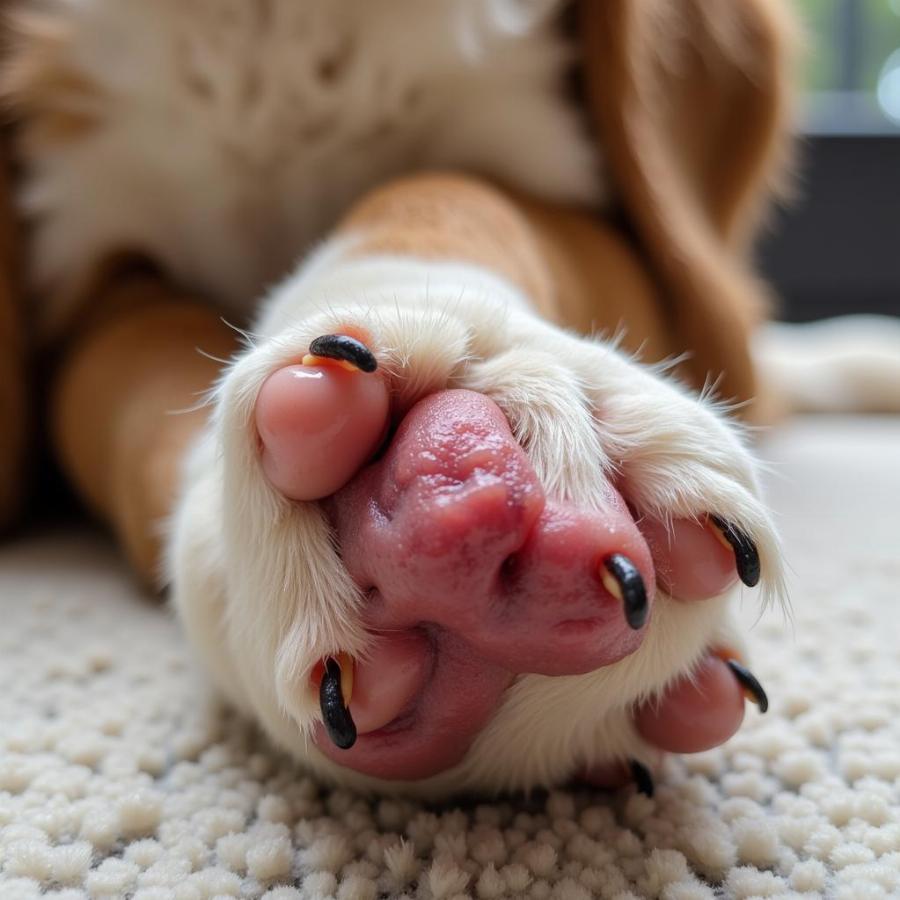A swollen paw can be alarming for any dog owner. This common condition can be caused by a variety of factors, ranging from minor injuries to serious underlying health issues. Recognizing the symptoms and understanding potential causes is crucial for providing appropriate care and seeking veterinary attention when necessary.
What Causes a Dog’s Paw to Swell?
There are numerous reasons why your dog’s paw might be swollen. Here are some of the most common culprits:
- Injuries: Trauma, such as a cut, puncture wound, burn, insect bite, or fracture, can cause inflammation and swelling in the paw pad.
- Infections: Bacterial, fungal, or parasitic infections can lead to paw pad inflammation and swelling.
- Allergies: Just like humans, dogs can have allergic reactions to various substances, including pollen, grass, mold, and even certain foods. These reactions often manifest as itchy and inflamed paws.
- Foreign objects: Thorns, splinters, glass shards, or other foreign objects lodged in the paw pad can cause pain, swelling, and infection.
- Arthritis: Joint inflammation associated with arthritis can lead to swelling and discomfort, especially in older dogs.
- Interdigital cysts: Fluid-filled sacs can develop between a dog’s toes, causing pain and swelling.
- Tumors: While less common, tumors or growths in the paw can also lead to noticeable swelling.
 Dog Paw Swollen from Injury
Dog Paw Swollen from Injury
Recognizing the Signs of a Swollen Paw
Identifying a swollen paw in your furry companion is relatively straightforward. Here’s what to look for:
- Visible swelling: The affected paw will appear larger than usual.
- Lameness or limping: Your dog may favor the injured paw and avoid putting weight on it.
- Redness or warmth: The swollen area might be redder or warmer to the touch than the surrounding skin.
- Licking or biting: Dogs often lick or bite at areas that are painful or uncomfortable.
- Discharge: If the swelling is caused by an infection, there might be discharge from the paw.
When to Seek Veterinary Care
If you notice any signs of a swollen paw, it’s essential to contact your veterinarian. While some causes are minor and can be managed at home, others require prompt medical attention to prevent complications.
Seek immediate veterinary care if your dog’s paw is:
- Severely swollen
- Accompanied by bleeding or a deep wound
- Exuding pus or foul-smelling discharge
- Extremely painful
- Showing signs of lethargy or loss of appetite
Diagnosing a Swollen Paw
To determine the underlying cause of your dog’s swollen paw, your veterinarian will likely perform a physical examination and ask about your dog’s medical history. They may also recommend diagnostic tests such as:
- Cytology: Examining a sample of cells from the affected area under a microscope to check for infection.
- X-rays: To identify fractures, foreign objects, or bone abnormalities.
- Blood tests: To rule out underlying medical conditions or infections.
Treatment Options for Swollen Paws in Dogs
Treatment for a swollen paw will depend on the underlying cause. Your veterinarian will recommend the most appropriate course of action based on their diagnosis.
Common treatment options include:
- Medications: Antibiotics for infections, anti-inflammatories to reduce swelling and pain, and antihistamines for allergies.
- Wound care: Cleaning and bandaging wounds to promote healing and prevent infection.
- Removal of foreign objects: Surgical intervention might be necessary to remove deeply embedded objects.
- Rest and restricted activity: Limiting your dog’s movement to allow the paw to heal.
- Cold compresses: Applying cold compresses to the affected area can help reduce swelling.
“Early intervention is key when it comes to treating swollen paws in dogs,” says Dr. Emily Carter, a renowned veterinarian specializing in canine orthopedics. “Prompt treatment not only alleviates discomfort but also minimizes the risk of complications and promotes a faster recovery.”
Preventing Swollen Paws
While not all causes of swollen paws are preventable, you can take steps to reduce the risk for your furry friend:
- Regularly check your dog’s paws: Inspect their paws after walks for cuts, thorns, or other foreign objects.
- Trim your dog’s nails: Overgrown nails can increase the risk of paw injuries.
- Provide a safe and clean environment: Keep your home and yard free of hazards that could potentially injure your dog’s paws.
- Consider protective booties: If your dog is prone to paw injuries, using booties during walks can provide an extra layer of protection.
Related Paw Problems
Swollen paws can sometimes be related to other paw problems, including:
For more information on these and other dog health concerns, visit our website or consult with a veterinarian.
Conclusion
A swollen paw in your dog should never be ignored. By being aware of the common causes, symptoms, and preventative measures, you can play a proactive role in ensuring your furry friend’s paw health. Remember, early detection and prompt veterinary care are essential for effective treatment and a speedy recovery.
If you suspect your dog may have a swollen paw, don’t hesitate to contact your veterinarian for guidance and support.
Have More Questions?
We’re here to help! If you have more questions about dog paw health or any other concerns about your furry companion, don’t hesitate to reach out to us.
For personalized advice and answers to your specific questions, please contact us at [email protected].
Beaut Dogs: Your Trusted Source for Dog Care Information
Beaut Dogs is your go-to resource for all things dog-related. We provide reliable, informative, and in-depth content to help you navigate the wonderful world of dog ownership.
From breed information and care guides to health tips and product recommendations, we’re here to support you every step of the way.